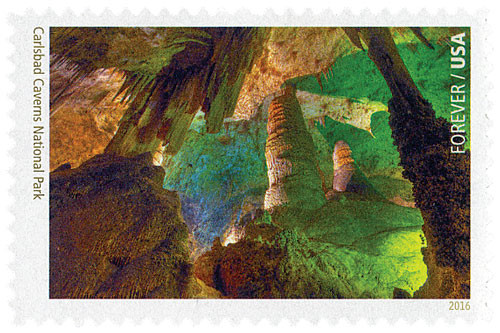
# 5080f - 2016 First-Class Forever Stamp - National Parks Centennial: Assateague Island National Seashore
US #5080f
2016 Assateague Island National Seashore – National Parks
- Honors Assateague Island National Seashore
- One of 16 stamps celebrating the 100th anniversary of the National Park Service
Stamp Category: Commemorative
Set: National Parks
Value: 47¢ First Class Mail Rate (Forever)
First Day of Issue: June 2, 2016
First Day City: New York, New York
Quantity Issued: 100,000,000
Printed by: Banknote Corporation of America
Printing Method: Offset, Microprint
Format: Panes of 16
Tagging: Phosphor tagged paper, block
Why the stamp was issued: To celebrate the beauty and natural wonders of Assateague Island National Seashore.
About the stamp design: Includes 16 designs, each picturing existing art or photographs of national parks or plants, animals, artwork, objects, or structures in national parks. The margins of each stamp includes the name of the location. coincide with the 100th anniversary of the National Park Service.
First Day City: The First Day of Issue Ceremony was held at the Javits Center in New York City as part of the World Stamp Show NY 2016.
About the National Parks set: Includes 16 stamp designs, each picturing existing art or photographs of national parks or plants, animals, artwork, objects, or structures in national parks. The margins of each stamp include the name of the location. Issued to coincide with the 100th anniversary of the National Park Service. The central image on the sheet of 16 pictures the 1¢ Yosemite postage stamp issued in 1934 along with the text “Our national parks tell distinctly American stories. Whether they inspire you to marvel at grand vistas, travel along scenic waterways and winding paths, or visit historic buildings and homes, discovery and exploration await.”
History the stamp represents: South of Ocean City, Maryland, is an inlet that separate Assateague and Fenwick Islands. Created by a hurricane in 1933, the inlet has been artificially kept open and the islands have since drifted over half-a-mile apart.
Almost as soon as Assateague became its own small land-mass, people began debating whether it should be developed or preserved. A small area was eventually built up, but the Ash Wednesday Storm of 1962 destroyed the one paved road and most buildings. Support increased for federal protection soon after.
In 1965, the northern half of the 37-mile-long island was established as the Assateague Island National Seashore, with a small section carved out for Maryland State Park. The southern portion, located entirely within Virginia’s state borders, became Chincoteague National Wildlife Refuge.
Each year, Assateague’s 41,320 acres offer visitors swimming, hiking, camping, fishing, and bird-watching. But the best known attraction on the island might be the wild horses. Though allowed to roam freely, these horses descended from domesticated animals and are actually more feral than they are wild. And some would argue that they should not be called horses at all, as their small stature technically classifies them as ponies.
US #5080f
2016 Assateague Island National Seashore – National Parks
- Honors Assateague Island National Seashore
- One of 16 stamps celebrating the 100th anniversary of the National Park Service
Stamp Category: Commemorative
Set: National Parks
Value: 47¢ First Class Mail Rate (Forever)
First Day of Issue: June 2, 2016
First Day City: New York, New York
Quantity Issued: 100,000,000
Printed by: Banknote Corporation of America
Printing Method: Offset, Microprint
Format: Panes of 16
Tagging: Phosphor tagged paper, block
Why the stamp was issued: To celebrate the beauty and natural wonders of Assateague Island National Seashore.
About the stamp design: Includes 16 designs, each picturing existing art or photographs of national parks or plants, animals, artwork, objects, or structures in national parks. The margins of each stamp includes the name of the location. coincide with the 100th anniversary of the National Park Service.
First Day City: The First Day of Issue Ceremony was held at the Javits Center in New York City as part of the World Stamp Show NY 2016.
About the National Parks set: Includes 16 stamp designs, each picturing existing art or photographs of national parks or plants, animals, artwork, objects, or structures in national parks. The margins of each stamp include the name of the location. Issued to coincide with the 100th anniversary of the National Park Service. The central image on the sheet of 16 pictures the 1¢ Yosemite postage stamp issued in 1934 along with the text “Our national parks tell distinctly American stories. Whether they inspire you to marvel at grand vistas, travel along scenic waterways and winding paths, or visit historic buildings and homes, discovery and exploration await.”
History the stamp represents: South of Ocean City, Maryland, is an inlet that separate Assateague and Fenwick Islands. Created by a hurricane in 1933, the inlet has been artificially kept open and the islands have since drifted over half-a-mile apart.
Almost as soon as Assateague became its own small land-mass, people began debating whether it should be developed or preserved. A small area was eventually built up, but the Ash Wednesday Storm of 1962 destroyed the one paved road and most buildings. Support increased for federal protection soon after.
In 1965, the northern half of the 37-mile-long island was established as the Assateague Island National Seashore, with a small section carved out for Maryland State Park. The southern portion, located entirely within Virginia’s state borders, became Chincoteague National Wildlife Refuge.
Each year, Assateague’s 41,320 acres offer visitors swimming, hiking, camping, fishing, and bird-watching. But the best known attraction on the island might be the wild horses. Though allowed to roam freely, these horses descended from domesticated animals and are actually more feral than they are wild. And some would argue that they should not be called horses at all, as their small stature technically classifies them as ponies.












